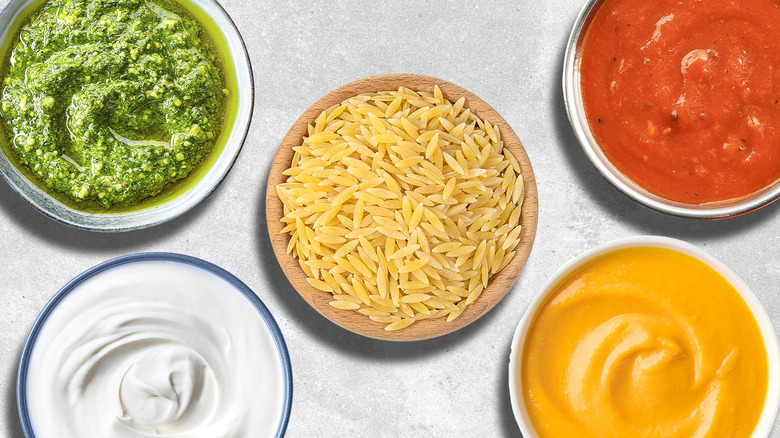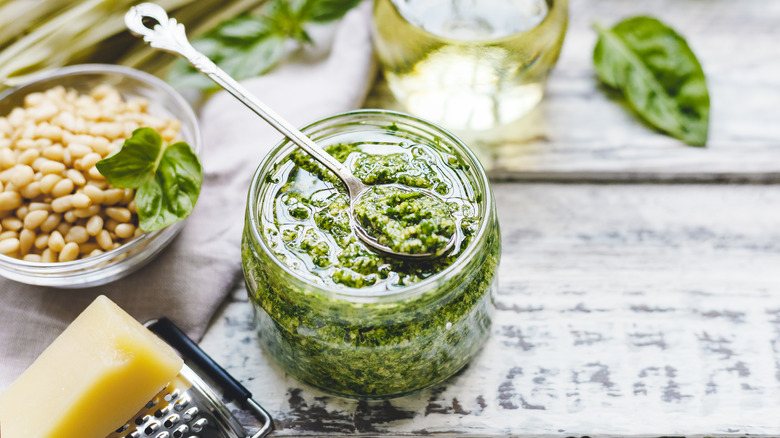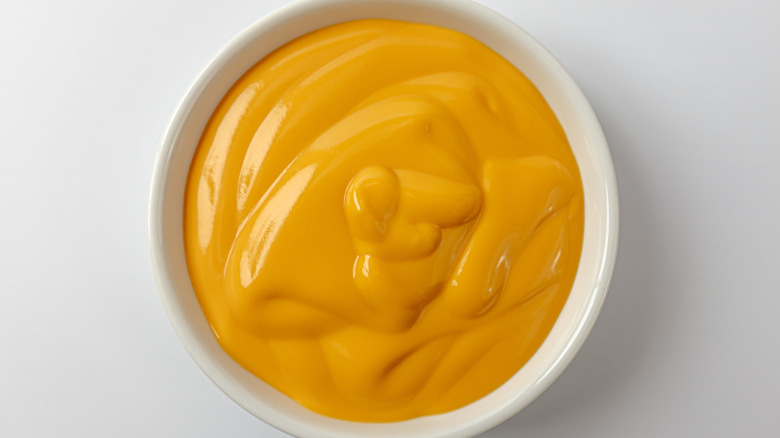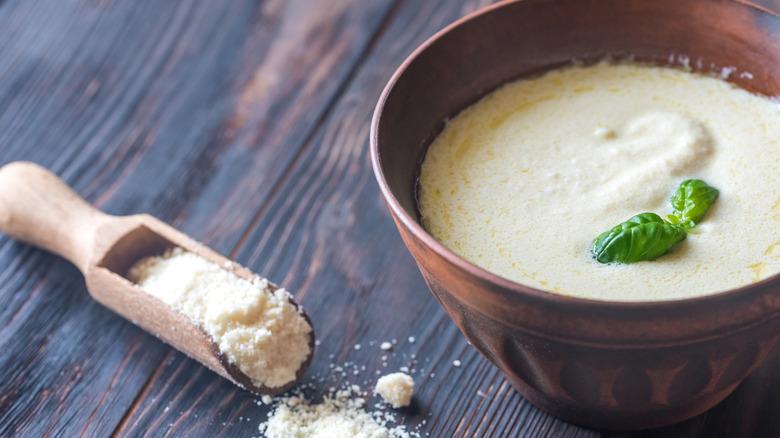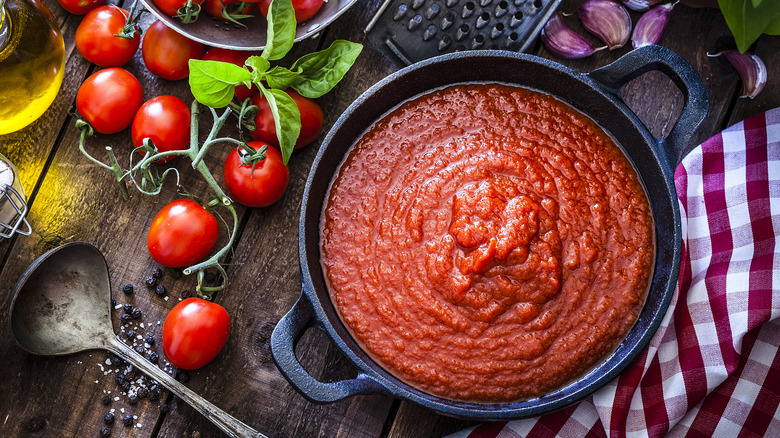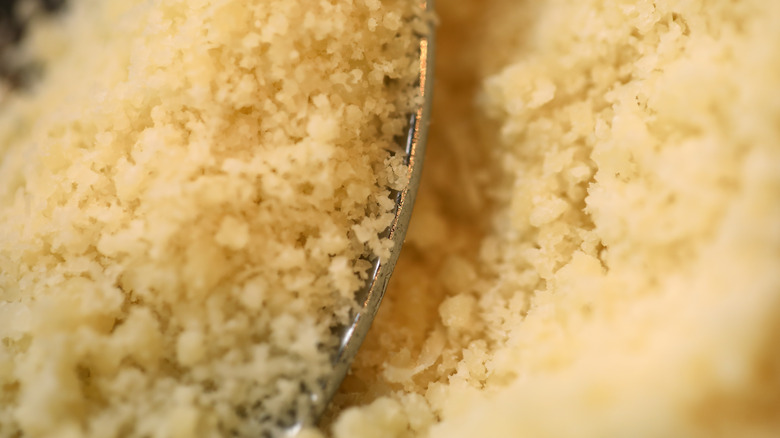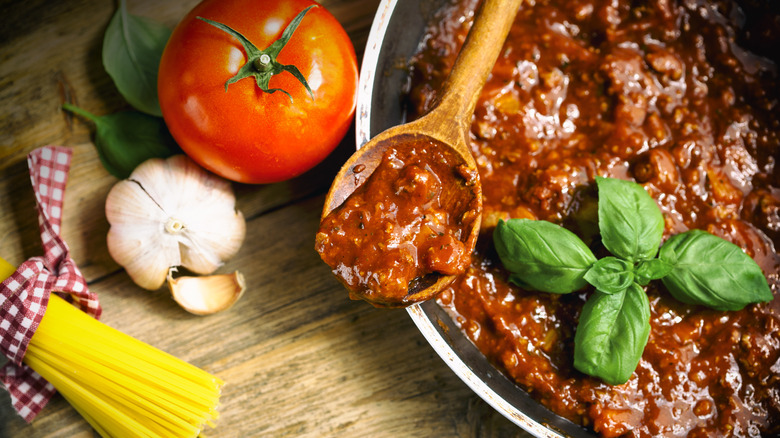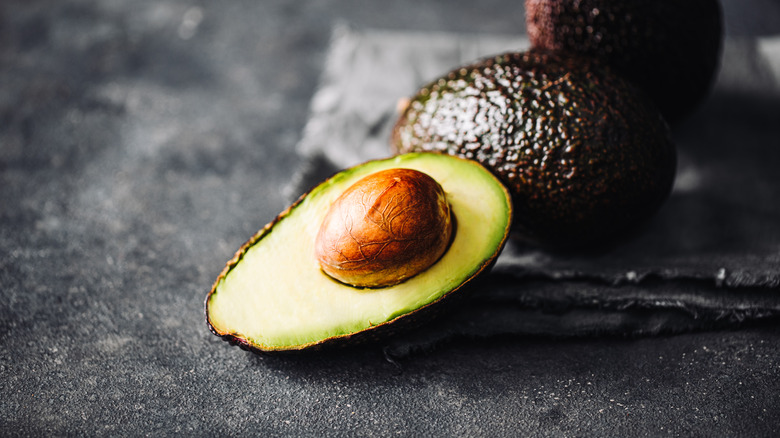11 Classic Sauces That Pair Nicely With Orzo
Upon first glance, a bowl of uncooked orzo may look like uncooked rice. Both orzo and rice are long, thin, and puff up after being cooked in water, but orzo walks a thin line between rice and pasta. Although it may look more like rice, it's more closely related to pasta — after all, it's made of wheat. However, if you haven't worked with this ingredient in the kitchen before, you may need some direction on how to get started.
After you master cooking orzo, you'll recognize it for what it is: a fun, simple ingredient you can use to change up the pasta recipes you have on rotation. We've created this list of some of the best sauces to pair your orzo with so you'll have an easier time cooking meals the whole family will love. Try the following classic sauce options, or go off the rails and try something completely different. Ultimately, cooking orzo (or anything, for that matter) is more fun when you make room for experimentation.
Pesto
If you're looking for a fresh sauce that packs in as many herbs as possible, you have to try pairing your orzo with pesto. We love this combination because pesto is light enough not to obscure the texture of the orzo but bold enough to create a massively flavored dish, no matter what other ingredients you decide to add to the mix. Spring or summer vegetables, such as asparagus, green peas, and diced tomatoes, make particularly solid additions.
If you want to make the simplest version of this dish, buy jarred pesto at the store. All you have to do from there is scoop some of the sauce onto the cooked orzo and, if needed, add extra olive oil to bring more fat or moisture into the dish. However, pesto is at its best when made fresh. If you have the time, it's worth making your own. Our bright and fresh pesto recipe is a great place to start.
If you have a blender or a food processor, it's super easy to place the herbs, garlic, cheese, and pine nuts inside and blitz the ingredients until they form a bright green, almost paste-like consistency. Add it to your cooked orzo, and you'll have a massively flavorful — but still pretty simple — dinner.
Olive oil-based sauces
Even if you're running low on groceries and don't have a lot of options in your fridge or pantry, you can still make a sauce to pair with orzo. The best easy, budget-friendly sauces all start with one ingredient: olive oil. We love olive oil-based sauces because they can be dressed up with spices or other ingredients and create a light but flavorful coating for your orzo. If you want to keep things simple, opt for our Mediterranean orzo recipe, which calls for orzo, veggies, and plenty of olive oil alongside a generous sprinkling of feta.
Of course, you can use even fewer ingredients to make a delicious orzo sauce. Start with an olive oil base, then add aromatics like garlic and scallions. If you want to pack in more flavor, use other seasonings like crushed red chili flakes, freshly cracked black pepper, and onion powder if you have some on hand. Olive oil's simplicity allows it to play well with all sorts of ingredients. Finish the cooked orzo with some Parmesan cheese, fresh herbs, or crispy fried onions, and you have a simple, satisfying side dish (or entree) to enjoy on a busy weeknight.
Pumpkin puree
Sometimes, unexpected ingredients can join forces to create deeply flavorful dishes you may have never imagined would turn out so well. This is the case when you add pumpkin puree to orzo. Does this combo seem a bit random? Sure. But believe us when we say that these two are a perfect match. Using pumpkin puree to create a sauce makes the finished product richer and creamier while offering a lighter alternative to sauces made with cream or butter.
If you've never ventured into the world of savory pumpkin dishes, this is your chance. Those who have only had sweet pumpkin desserts may find adding pumpkin puree to a pasta dish strange, but it all comes down to the seasonings you use. Salt, black pepper, and some veggie or chicken broth can help give your pumpkin puree a saltier, savory flavor profile you're going for when you make orzo. Plus, pumpkin adds a creamy, nutritious dimension to an otherwise ordinary pasta dish. Why not give it a try? Use the canned stuff, and you won't have to wait for the fall to indulge.
Cheese
Mac and cheese gets the first half of its name from the pasta commonly used in this classic dish: macaroni. As such, elbow macaroni seems like the most reasonable choice for this fan-favorite pasta dish — but it's not the only available option. Truthfully, you can use practically any pasta type to make mac and cheese, but shorter varieties generally mimic the original better than longer shapes do. What's one of the smallest and shortest varieties out there? Orzo, of course!
If you're searching for a new way to make a classic mac and cheese, pair your favorite cheese sauce recipe with orzo instead of macaroni. We love the way a cheesy sauce melts into cooked orzo, creating a creamy, deeply satisfying dish that kids and adults will like. Keep it simple with a cheese sauce made from American or cheddar cheese, or upgrade orzo mac and cheese by using Brie or another type of soft, rich cheese. You may never want to make mac and cheese the old way again.
Alfredo
Go to an Italian American restaurant in pretty much any city in the United States, and you will likely see two sauces featured prominently on the menu. One is a red sauce, which can be prepared with or without meat. The other is Alfredo sauce, which happens to pair exceptionally well with orzo. This white, creamy sauce packs a lot of flavor for something that looks so bland — and can provide texture and flavor to a bowl of cooked orzo.
We love using jarred sauce because it is incredibly easy to add to cooked pasta, including orzo, creating a simple and easy weeknight meal. However, if you feel like being a bit fancier, you can always try making Alfredo sauce from scratch. Another important note: Since this is such an intense, creamy sauce, you will probably want to break up all the monotony of cream and cheese with other ingredients, like broccoli, chicken, or even some crispy tofu. Throw it all together, and you'll have an orzo dish the whole family will enjoy.
Marinara
There are few sauces more classic than a basic marinara, which we happen to think pairs well with just about any kind of pasta. Orzo is no exception. Bright, acidic, and deeply flavorful marinara sauce is classic, comforting, and will appeal to even the pickiest of palates. In short, it's an easy choice if you're feeding kids or other people who may have a lot of limitations on what they eat. You can easily find jars of marinara sauce at your local grocery store, but it's not that hard to make at home, whether you choose to use canned or fresh tomatoes. Make sure to add plenty of garlic and spices into the sauce as it simmers, and you'll have a flavorful base that is sure to take your orzo dish up a notch.
Marinara is a delicious sauce, but it can be a bit boring all on its own. Don't be afraid to dress your marinara sauce up with complementary, pungent ingredients like fried garlic, fish sauce, and Parmesan cheese. We also love topping our marinara-sauced orzo with a generous heap of fresh herbs and finish it all off with an extra drizzle of olive oil.
Cacio e pepe
Perhaps no sauce in the Italian canon is as simple — or as delicious — as cacio e pepe. This is the sauce you make when you have nothing in the kitchen. Simple as it is, we think it may be one of the very best ways to prepare orzo, especially if you're a true cheese lover. All you'll need for this sauce is butter, black pepper, and Pecorino Romano cheese. Some recipes don't even call for the butter at all, instead opting to use the leftover starch in the pasta water to create that creamy sauce we love, but we'll leave it up to you to decide if you want to add it. Start with a classic cacio e pepe recipe and make tweaks later if needed.
Here are some things to consider when approaching this dish: Because you're using very few ingredients, you'll want to ensure each one packs a dose of flavor. This is why we'll always opt for freshly ground black pepper over the pre-ground powdered stuff you can buy in huge containers at the grocery store. Similarly, look for some decent pecorino for the best flavor in your finished product. Since this sauce ends up being so light, it's the perfect complement to small, rice-like orzo pasta.
Bolognese
You may think of Bolognese sauce as something you would only use with long pasta like spaghetti or tagliatelle, but that's not the case. Because the meat in Bolognese sauce is so well-minced, it's also perfect for smaller pasta shapes like orzo. If you're looking for a way to bulk up your orzo and transform it into a dish you'd want to eat in the winter, adding some Bolognese sauce is a smart move.
When you want to keep things as simple as possible (or you don't feel like cooking), store-bought and jarred Bolognese can be a great ingredient to have at the ready. However, we think the flavor of homemade Bolognese is worth the time and effort it takes to make it from scratch. Plus, it'll make your kitchen smell great while the sauce is simmering away. When it's done cooking, pour it over your cooked orzo and stir to incorporate.
Lemon-based sauces
Orzo is often served in light, bright dishes that work best in the warmer months. Therefore, you might consider a lemon-based sauce for your next orzo dish. If you're making an orzo-based salad, a simple combination of lemon juice and olive oil creates a delicious, satisfying dressing that works as well on veggies and other ingredients as on orzo. However, if you want a greater intensity of lemony flavor, add some zest to the mix for a more pronounced punch.
Remember that lemon-based sauces can't rely on lemon alone; they need some type of fat to tame all that acid. Olive oil works well in many dishes, particularly if you plan to serve the orzo cold, but you can also make warm sauces using other types of fat, like butter, to serve as the base. Whatever you choose, reaching for fresh lemon brings an unmistakable brightness that makes eating pasta feel less heavy and rich — but still extremely satisfying.
Yogurt
Do you have some leftover plain or Greek yogurt in your fridge? You're in luck; this ingredient can create ultra-flavorful pasta sauces that take orzo to a new level. If you're using good-quality yogurt, all you need to do is add some salt and pepper to make a creamy, flavorful sauce that can be added to many pasta dishes, including those made with orzo. However, you can (and should) add other ingredients to the mix if you have the time and energy to make something more exciting.
In particular, we love using yogurt-based sauces to make orzo pasta salad. First, combine yogurt with olive oil and lemon juice and season it to your liking. Then, add plenty of vegetables, beans, and whatever else you want to enjoy with your orzo to the mix. Ultimately, the role yogurt plays in pasta salad is like mayonnaise; it results in a creamy, decadent sauce that should be served cold.
Avocado-based sauces
Few ingredients can make a creamier, more delicious sauce for orzo than avocado. Of course, you don't have to make a sauce at all to utilize avocado in your orzo dishes; you can chop up this ingredient and mix it into the pasta without any further effort. However, if you're willing to do some extra work, it makes a sauce capable of taking any pasta dish to the next level.
Start by mashing or processing your avocado. When choosing an avocado for the job, you'll want to look for one that is quite ripe and soft, which makes for easier sauce-making. Afterward, add other ingredients like olive oil, lemon juice, and seasonings to taste. Herbs can brighten an avocado-based sauce to make it taste fresher and more flavorful. We recommend blending these ingredients until they're nice and creamy or keeping things chunky for a more texturally rich orzo dish. Add other ingredients (or don't), and serve this creamy, green, and nutritious orzo dish to the avocado lovers in your life.
